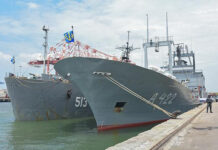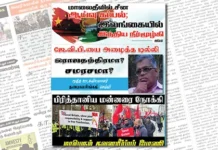Sri Lanka and India have cemented their long-standing ties with a rush of energy and maritime deals amid a push by New Delhi for more strategic influence in the region to counter China’s rising clout – even as analysts warn Colombo against becoming overreliant on its larger neighbour.
Both South Asian nations agreed to boost maritime, air, energy and power cooperation, among other areas, during Sri Lankan President Ranil Wickremesinghe’s meeting with Indian Prime Minister Narendra Modi last month.
A number of ports – including Colombo on Sri Lanka’s western coast, Trincomalee in the east and Kankesanthurai on the northernmost tip of the island country facing the Palk Strait separating it from India – are set to be developed.

An oil pipeline connecting Sri Lanka and India was agreed, alongside a high-capacity power grid to enable “bidirectional electricity trade” between the island and the wider region, including Bangladesh, Bhutan and Nepal – other member countries of the so-called BBIN subregional initiative for economic cooperation.
Both leaders also agreed to collaborate on green, or carbon-free, ammonia and green hydrogen – considered by some to be a “fuel of the future” as it is derived from water using renewable energy sources.
Given Sri Lanka’s crippling energy shortages last year and lack of foreign currency to import fuel, analysts say the collaboration could help the country shift towards more renewable energy sources, thereby lowering overall fuel consumption.
However, the key is not to rely too much on external power sources, they said.
‘Triangle of death’
India’s interest in Sri Lankan energy and port projects is part of a continued strategy to maintain a dominant position in South Asia, where China has recently been seeking influence.
While Delhi has traditionally had strong ties with its southern neighbour and is also among Sri Lanka’s biggest creditors, the small island nation’s strategic location in the Indian Ocean has turned it into an India-China jousting ground.
Aruna Kulatunga, an independent political and energy analyst from Sri Lanka, said India viewed the nation – alongside Bangladesh and Pakistan – as “de facto satellite states of China, because they have leased out land to China”.

The three Chinese-run ports in the region – Chittagong in Bangladesh, Hambantota in Sri Lanka and Gwadar in Pakistan – form what’s been referred to as a “triangle of death” encircling India, according to Kulatunga.
“For [India] it is like strangulation”, he said, as it means Delhi needs to put more resources into protecting vital sea routes.
This makes Delhi’s move to deepen ties with Colombo a way of seeking “psychological comfort”, Kulatunga said, as it expands influence in an area where Beijing already exerts control.
Trincomalee, one of the largest natural harbours in the world, does not currently have the facilities to service the most modern vessels. Delhi insisted on developing the port because it wanted to have “something outside India, but within the triangle”, Kulatunga said.
Earlier this week, Khanjar, a Khukri-class corvette of the Indian Navy, visited Trincomalee port for three days, with the visit being hailed by the Indian high commission in Colombo as “augmenting [the] capabilities of the Sri Lanka Navy” in addressing regional maritime challenges.
The visit came amid projections by the US-based AidData research project that Sri Lanka’s Hambantota port is the most likely to host a Chinese naval base, as Beijing seeks to expand its maritime capabilities.
George I.H. Cooke, a historian and academic who formerly worked for Sri Lanka’s diplomatic service, told This Week in Asia that the recent deals with India had more to do with political engagement than Delhi rivalling Beijing.
“India is undoubtedly the strongest player in the [South Asia] region, and has been in that position for some time. That position only keeps growing,” said Cooke, who also initiated the Awarelogue Initiative, a platform to generate awareness and dialogue in international relations with a focus on Sri Lanka’s foreign policy.
More interdependence and connectivity was a positive, said Rajni Gamage, a political-science researcher at the National University of Singapore – but in practice the power imbalance between India and Sri Lanka means that these initiatives need a good deal of transparency and for Colombo’s negotiators to be on their game.
“Political leaders could use the language of ‘crisis’ in order to push through some top-down, one-sided deals,” Gamage said.

Power play
Deals prioritising the interests of the political and business elite could adversely affect the needs of local communities and more vulnerable sections of Sri Lankan society, analyst Kulatunga warned.
He cited the example of the Adani Group, which has been leveraging India’s strategic interest in Sri Lanka to control the supply of power between the countries.
The controversial conglomerate – accused of accounting fraud and stock manipulation earlier this year – has already won a US$442 million wind power project in northern Sri Lanka. It’s also expected to handle projects such as the oil pipeline, joint power grid with India and the harnessing of green hydrogen from Sri Lanka.
Adani has promised to buy back electricity from Sri Lanka as the grids connect, but “this will never happen because the unit of production of electricity is lower in India”, Kulatunga said.
The cost of one kilowatt of electricity for household consumption was 7.9 US cents in India as of December last year, while in Sri Lanka it was 8.7 US cents.
Such an imbalance threatens to cripple the further development of Sri Lanka’s power generation capacity, especially renewable energy, if India becomes a net exporter of electricity to the island nation, Kulatunga warned.
“[Sri Lanka] is going to be connected by this umbilical cord to India, and anytime they want, they can cut us off,” he said.
Historian Cooke said that while enhanced forms of connectivity remained critical in the short term to meet Sri Lanka’s increased demand for electricity, it was crucial for the country to develop alternative sources of energy to ensure self-reliance in the long run.
“That is where Sri Lanka will have diversity [in its] energy sources and not just one pipeline,” he said.






